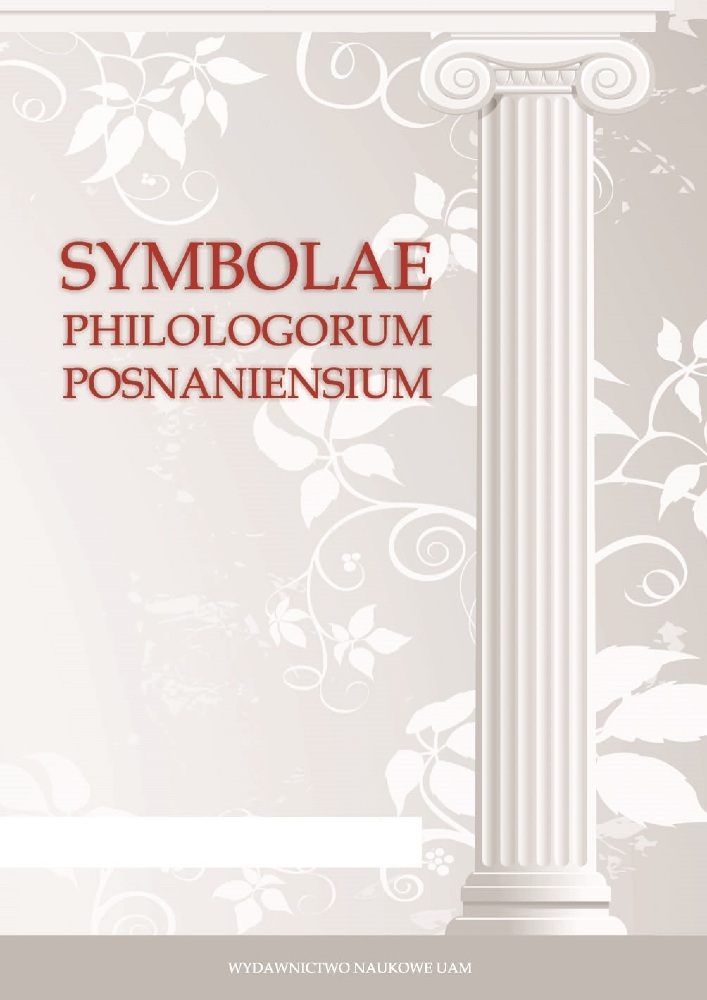Abstrakt
The text is an analysis of the story of Dido as shown in Virgil’s Aeneid. The author presents pre-Virgilian
sources of the history of the Phoenician queen, recounts the three principal versions of Dido’s biography and
sets the Virgil’s narration against the opinions of ancient commentators (Servius, Macrobius) and other Roman
writers reminiscing about Dido’s ill-fated past. All the testimonies bring out the uncontestable claim that it was
Virgil who first wrote about the tragic love entanglement between Aeneas and Dido, a story which rapidly gained
popularity upon the publication of the Aeneid. The article discusses Virgil’s subversive understanding of
gender and the conventional traits of national character (Roman and barbaric, as typified in Roman literature).
Bibliografia
Źródła
Anthologia Latina: Anthologia Latina sive Poesis Latinae Supplementum, F. Buecheller, A. Riese
(ed.), Amsterdam 1973.
Apollonius Rhodius, Argonautica, R.C. Seaton (ed.), London – New York 1912.
Callimachus, Fragmenta, R. Pfeiffer (ed.), Oxford 1949.
Auson., Cupido Cruciatur: Decimus Magnus Ausionius, Works, vol. I, H.G. Evelyn-White (ed.)
London, Cambridge, 1919.
Ennianae Poesis Reliquiae 290: J. Vahlen (ed.), Leipzig 1903.
FGrH: Fragmenta Historicorum Graecorum, K. Müller, T. Müller, V. Langlois (ed.), Parisiis
–1869.
Etymologion Magnum: seu verius Lexicon Saepissime Vocabulorum Origines Indagans ex Pluribus
Lexicis Scholiastis et Grammaticis Anonymi Cuiusdam Opera Concinnatum, Gaisford
(ed.), Oxford 1848.
Gaius, Institutiones, P. Krüger, G. Studemund (ed.), Berlin 1891.
Aulii Persii Flacci et D. Iunii Iuvenalis Saturae, W.V. Clausen (ed.), Oxford 1992.
Macrobii Ambrosii Theodosii, Saturnalia, R.A. Kaster, Oxford 2011.
Naevius, fr. 14 FPL: Fragmenta poetarum latinorum epicorum et lyricorum praeter Ennium et
Lucilium, C. Buechner (ed.), Leipzig, 1982.
Publius Ovidius Naso, Heroides – Ovid, Heroides and Amores, G. Showerman (ed.), New York
Publius Ovidius Naso, Tristia – Ovid, Tristia. Ex Ponto, A.L. Wheeler, G.P. Goold (ed.), Harvard
P. Ovidii Nasonis Metamorphoses, W.S. Anderson (ed.), Leipzig 1985.
C. Plinii Caecilii Secundi Epistularum libri decem, R.A.B. Mynors (ed.), Oxford 1963.
C. Plinii Caecilii Secundi, Naturalis historiae libri XXXVII, K. Mayhoff (ed.), Leipzig 1875–1906.
L. Annei Senecae, Ad Lucilium epistulae morales, L.D. Reynolds (ed.), Oxford 1965.
Maurus Servius Honoratus, In Vergilii carmina comentarii. Servii Grammatici qui feruntur in
Vergilii carmina commentarii, H. Hagen, G. Thilo (ed.), Leipzig 1881.
Marcus Iunianus Iustinus, Epitoma Historiarum Philippicarum, M.-P. Arnaud-Lindet (ed.), 2003.
G. Iulius Solinus, De mirabilibus mundi, T. Momsen (ed.), Leipzig 1895.
Statius, Silvae, D.R. Shackleton Bailey, Ch.A. Parrot (ed.), Harvard 2015.
Domitii Ulpiani, Fragmenta, G. Hugo (ed.), Berlin 1834.
P. Vergili Maronis, Aeneis, O. Ribbeck (ed.), Leipzig 1915.
Aelius Donatus, Vita Vergiliana – Vitae Vergilianae, J. Brummer (ed.), Leipzig 1912.
Westermann 1839: Paradoxographoi: scriptores rerum mirabilium graeci : insunt (Aristotelis)
Mirabiles auscultationes, Antigoni, Apollonii, Phlegontis Historiae mirabiles, Michaelis
Pselli Lectiones mirabiles, reliquorum eiusdem generis scriptorum deperditorum fragmenta:
accedunt Phlegontis Macrobii et Olympiadum reliquiae et anonymi tractus De mulieribus,
etc., A. Westermann (oprac.), Londini, 1839.
Opracowania i komentarze
Akbar Khan 1968: H. Akbar Khan, Dido and the Sword of Aeneas, „Classical Philology” 63, 1968,
nr 4, 283–285.
DeGraff 1932: T.B. DeGraff, Antigone and Dido, „The Classical Weekly” 25, 1932, nr 19, 148–
DeGraff 1950: T.B. DeGraff, Dido: Tota Vergiliana, „The Classical Weekly” 43, 1950, nr 10,
–151.
Edgeworth 1976: R.J. Edgeworth, The Death of Dido, „The Classical Journal” 72, 1976 – 1977,
nr 2, 129–133.
Gruen 2012: E.S. Gruen, Rethinking the Others in Antiquity, Princeton 2012.
Hill 2004: T. Hill, Ambitiosa Mors. Suicide and the Self in Roman Thought and Literature, New
York and London 2004.
van Hoof 1990: A. van Hoof, From Autothanasia to Suicide. Self-killing in Classical Antiquity,
New York and London 1990.
Jacobson 2005: H. Jacobson, Dido, „Mnemosyne” 58, 2005, nr 2, 581–582.
Kolańczyk 2001: K. Kolańczyk, Prawo rzymskie, Warszawa 2001, 226
Litewski 1995: W. Litewski, Rzymskie prawo prywatne, Warszawa 1995, 160
Matusiak 2015: P. Matusiak, Obraz Hannibala w literaturze antycznej, Katowice 2015, 27–60.
McLeish 1978: K. McLeish, Dido, Aeneas, and the Concept of ‘Pietas’, „Greece & Rome” 19,
, nr 2, 127–135.
Moles 1984: J.L. Moles, Aristotle and Dido’s Hamartia, „Greece & Rome” 31, 1984, nr 1, 48–54.
Nappa 2007: C. Nappa, Unmarried Dido: Aeneid 550–52, „Hermes” 135, 2007, nr 3, 301–313.
Odgers 1925: M.M. Odgers, Some Appearences of the Dido Story, „The Classical Weekly” 18,
, nr 19, 145–148.
Perret 1964: J. Perret, Les compagnes de Didon aux Enfers (Aen. VI, 445–449), „Revue des Études
Latines” 42 (1964), 247–261.
Phinney 1965: E. Phinney, Jr., Dido and Sychaeus, „The Classical Journal” 60, 1965, nr 8, 355–
Pöschl 1962: V. Pöschl, The Art of Vergil: Image and Symbol in the Aeneid, trans. G. Seligson,
Ann Arbor 1962.
Sapota 2009: T. Sapota, Rzymska idea samobójstwa, „Symbolae Philologorum Posnaniensium
Graecae et Latinae” XIX, 2009, 281–287.
Starks, Jr. 1999: J.H. Starks, Jr., Fides Aeneia: The Transference of Punic Stereotypes in the Aeneid,
„The Classical Journal” 94, 1999, nr 3, 255–283.
Starr 1991: R.J. Starr, Dido to Your Son: Tiberius Claudius Donatus on Vergil’s Dido, „The Classical
Journal” 87, 1991, nr 1, 25–34.
Starry West 1980: G. Starry West, Caeneus and Dido, „Transactions of the American Philological
Association” 110, 1980, 315–324.
Wesołowska 2015: E. Wesołowska, Dydona pisze do Eneasza, [w:] A. Szastyńska-Siemion, Charisteria,
Wrocław 2015, 261–272.
Licencja
